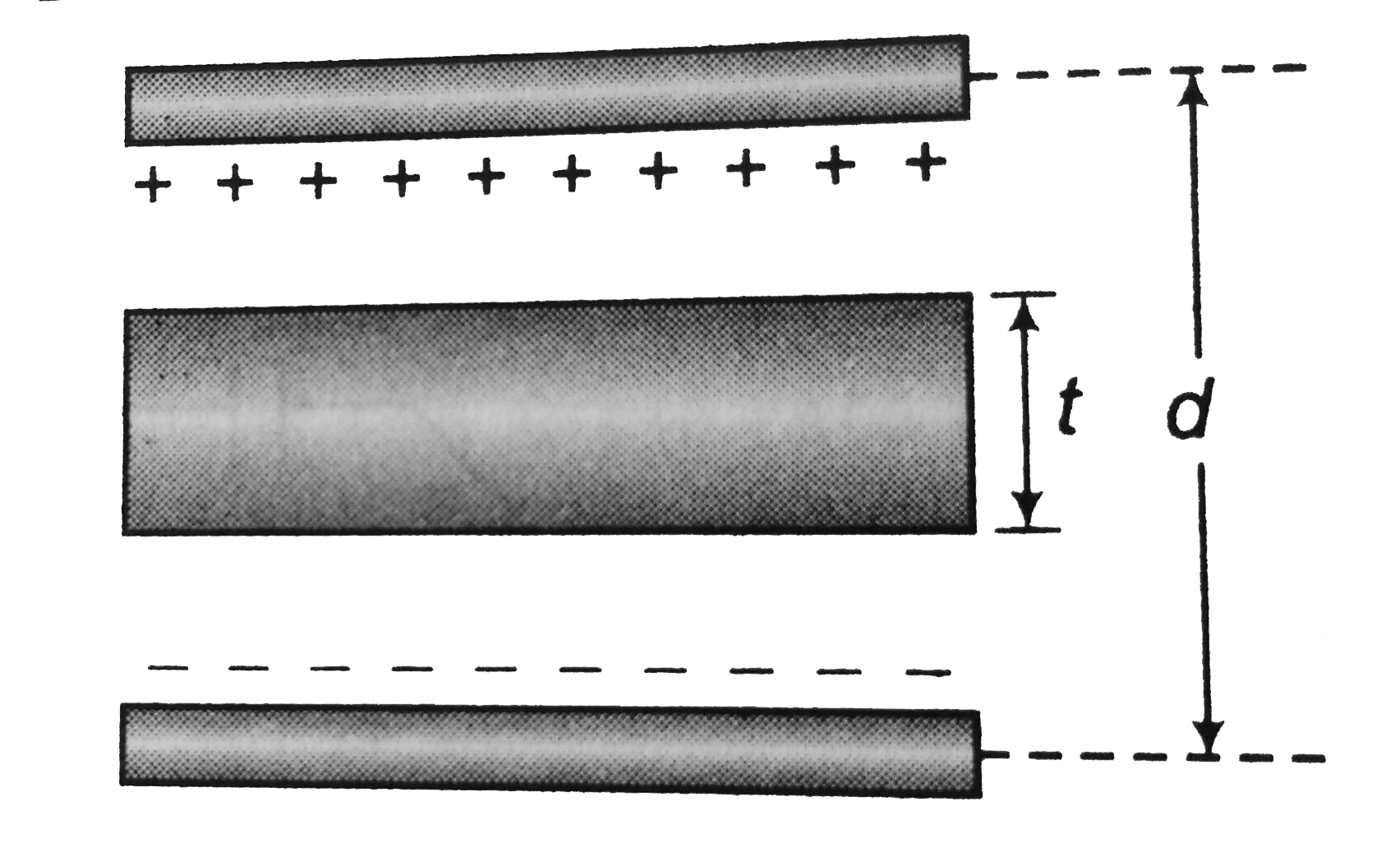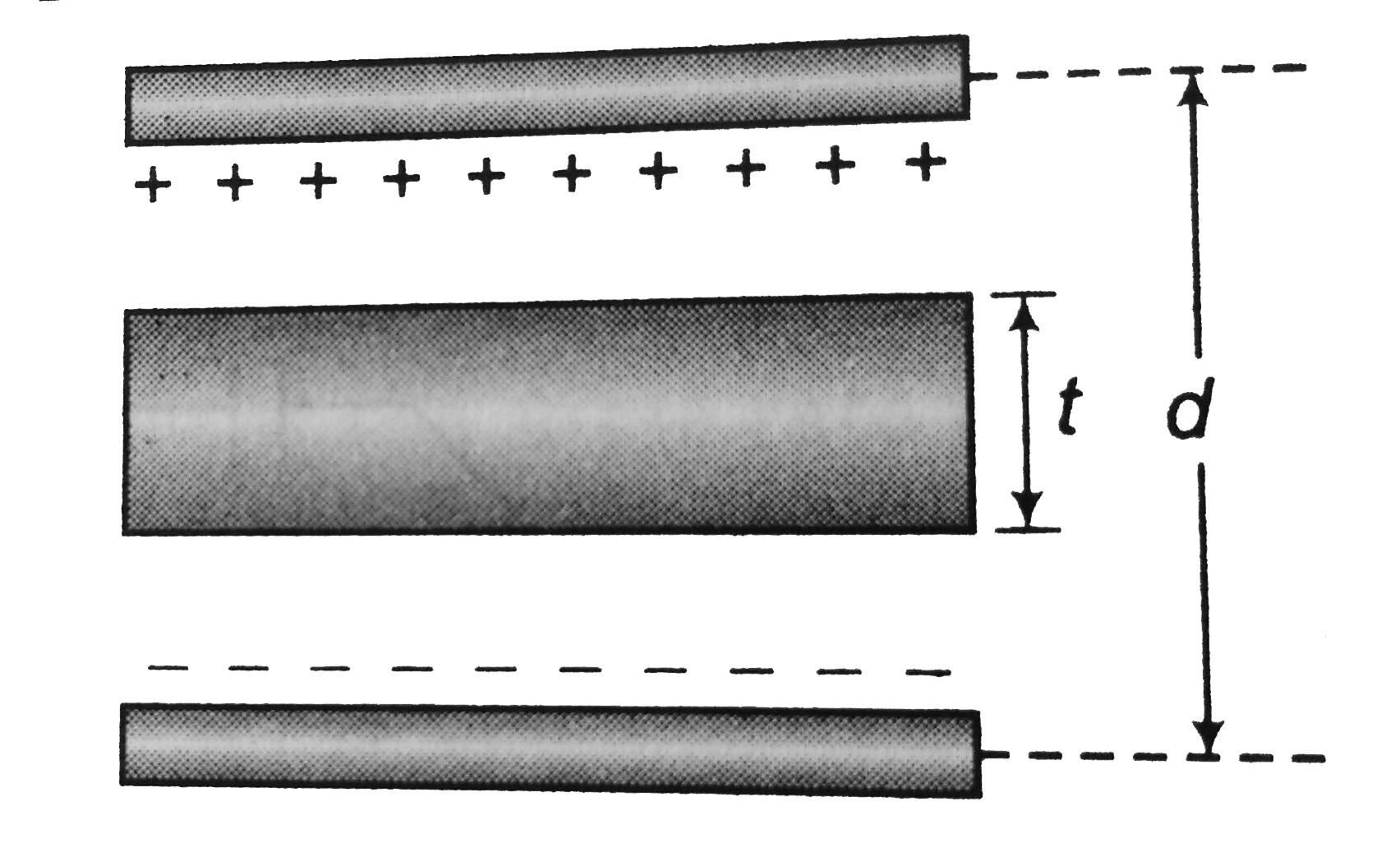Shown a parallel plate capacitor with plates of width b and length l. The separation between the platesis d. The plates are rigidly clamped and connected to a battery of emf V. A dielectric slab of thickness d and dielectric constant K is slowly inserted between the plates. (a) Calculate the energy of the system when a length x of the slab is introduced into the capacitor. (b) what force should be applied on the slab to ensure that is goes slowly into the capacitor? Neglect any effect of friction or gravity.

The plate area of the part with the dielectric is bx. Its capacitance is <br> C_1 = (K epsilon_0 bx)/(d)<br>. Similarly, the capacitance of the part without the dielectric is <br>C_2 = (epsilon_0 b)/(d) [ l + x (K- 1)]. The energy of the capacitor is <br>U = (1)/(2) CV^2<br> <br>= (epsilon_0 bV^2)/( 2 d) [ l + x(K-1)]<br>. (b) Suppose, the electric field attracts the dielectric slab with a force F. An external force of equal magnitude F should be applied in opposite direction so that the plate moves slowly ( no acceleration). Consider the part of motion in which the dielectric moves a distance dx further inside the capacitor. The capacitance increases to C+dC. As the potential difference remains constant at V, the battery has to supply a further charge <br> dQ = (dC)V<br> to the capacitor. The work done by the battery is, therefore, <br>dW_b = V dQ = (dC)V^2<br>. The external force F does a work <br>dW_e = (-F dx)<br> during the displacement. The total work done on the capacitor is <br> dW_b +dW_e = (dC)V^2 - Fdx<br>. this should be equal to the increase dU in the stored energy. thus, (1)/(2) (dV)V^2 = (dC)V^2- Fdx<br>. or, F = (1)/(2) V^2 (dC)/(dx). Using equation (i) F=ε0bV2(K−1)(2d)
Thus, the electric field attracts the dielectric into the capacitor with a force ε0bV2(K−1)2d and this much force should be applied in the opposite direction.
Topper's Solved these Questions
- BOOK - HC VERMA ENGLISHCHAPTER - CAPACITORSEXERCISE - Objective 112videos
CAPACITORS
- BOOK - HC VERMA ENGLISHCHAPTER - CAPACITORSEXERCISE - OBJECTIVE 26videos
CAPACITORS
- BOOK - HC VERMA ENGLISHCHAPTER - CAPACITORSEXERCISE - short answer7videos
CAPACITORS
- BOOK - HC VERMA ENGLISHCHAPTER - BOHR'S MODEL AND PHYSICS OF THE ATOMEXERCISE - Short Answer10videos
BOHR'S MODEL AND PHYSICS OF THE ATOM
- BOOK - HC VERMA ENGLISHCHAPTER - DISPERSION AND SPECTRAEXERCISE - Question for short Answer6videos
DISPERSION AND SPECTRA
Similar Questions
Figure shows a parallel-plate capacitor with plates of width b and length l. The separation between the plates is d. The plates are rigidly clamped and connected to a battery of emf V. A dielectric slab of thickness d and dielectric constant K is slowly inserted between the plates. Calculate the energy of the system when a length x of the slab is introduced into the capacitor.
 View Solution
View SolutionA parallel plate capacitor has plate of length 'l' width 'w' and separation of plates is 'd' . It is connected to a battery of emf V . A dielectric slab of the same thickness 'd' and of dielectric constant k=4 is being inserted between the plates of the capacitor . At what lenght of the slab inside plates , will the energy stored in the capacitor be two time the initial energy stored ?
View SolutionConsider the diagram,

A parallel plate capacitor has the plate width t and length L while the separation between the plates is d. The capacitor is connected to a battery of voltage rating V. A dielectric which carefully occupy, the space between the plates of the capacitor is slowly inserted between the plates. when length x of the dielectric slab is introduced into the capacitor, then energy stored in the system isView SolutionA parallel plate capacitor of capacitance 90 pF is connected to a battery of emf 20 V. If a dielectric material of dielectric constant K=53 is inserted between the plates, the magnitude of the induced charge will be :
View SolutionA capacitor with plate separation d is charged to V volts. The battry is disconnected and a dielectric slab of thickness d2 and dlelectric constant '2' is inserted between the plates. The potential difference across its terminals becomes
View SolutionSeparation between the plates of a parallel plate capacitor is d and the area of each plates is A. When a slab of material of dielectric constant k and thickness t(t<d) is introduced between the plates. Its capacitance becomes
View SolutionFigue shows a parallel plate capacitor with plate area A and plate separation d. A potential difference is being applied between the plates. The battery is then disconnected and a dielectric slab of dieletric constant K is placed in between the plates of the capacitor as shown.

The electric field in the dielectric slab isView SolutionFigure shows a parallel plate capacitor with plate area A and plate separation d. A potential difference is being applied between the plates. The battery is then disconnected and a dielectric slab of dieletric constant K is placed in between the plates of the capacitor as shown.

The electric field in the gaps between the plates and the electric slab will beView SolutionTwo identical parallel plate capacitors are connected in series to a battery of 100V. A dielectric slab of dielectric constant 4.0 is inserted between the plates of second capacitor. The potential difference across the capacitors will now be respectively
View SolutionA parallel plate capacitor each with plate area A and separation ‘d’ is charged to a potential difference V. The battery used to charge it is then disconnected. A dielectric slab of thickness d and dielectric constant K is now placed between the plates. What change if any, will take place in
(i) charge on the plates
(ii) electric field intensity between the plates,
(iii) capacitance of the capacitor
Justify your answer in each caseView Solution

